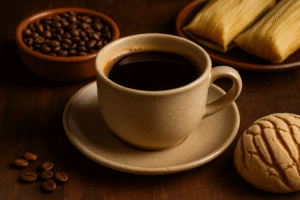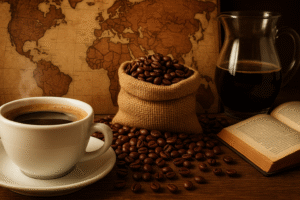In today’s digital world, coffee and social media go hand in hand. What was once a simple morning ritual has become a global aesthetic, a storytelling device, and a lifestyle emblem. Social media hasn’t just changed the way we share coffee—it has changed the way we drink it.
From Instagram-worthy lattes to TikTok coffee hacks, the culture around coffee has been reimagined through the lens of social platforms. This connection reflects deeper shifts in consumer behavior, identity formation, and community building.
Coffee as a Visual Symbol
Coffee is inherently photogenic. The textures of latte foam, the swirling cream in iced coffee, the warm glow of a sunlit café—all translate beautifully into images and videos.
Social media platforms thrive on visual content, and coffee provides the perfect subject. It’s simple, relatable, and tied to moments of comfort, productivity, and indulgence.
These images are not just casual shares—they’re curated statements. A coffee post signals taste, lifestyle, and alignment with certain aesthetic values.
The Rise of the Coffee Aesthetic
On platforms like Instagram and Pinterest, coffee has become part of an entire visual culture. Neutral tones, ceramic mugs, clean lines, and cozy lighting dominate the feed.
The “coffee aesthetic” blends elements of minimalism, mindfulness, and quiet luxury. It’s not about the brand—it’s about the feeling the image evokes.
Creators arrange flat lays, use filters, and even style their workspace or outfits around a cup of coffee.
This aesthetic reinforces the idea that coffee is not just a beverage, but a central element of personal identity.
Coffee and Morning Routines Online
The rise of “morning routine” content has made coffee a star. Videos showcasing peaceful mornings often begin with the sound of beans grinding or milk frothing.
On TikTok and YouTube, creators invite audiences into their routines—many built around coffee preparation.
This content blends productivity, wellness, and lifestyle, creating a genre where coffee is both a ritual and a performance.
People don’t just watch for recipes—they’re looking for inspiration, motivation, and a sense of belonging.
Influencers and Coffee Branding
Coffee companies now partner with influencers to reach niche audiences. Instead of traditional ads, brands leverage authenticity through social voices.
Influencers promote coffee subscriptions, new brewing gadgets, and even café chains—often incorporating the product into their daily lives naturally.
These collaborations feel more personal and less invasive, making them highly effective.
For influencers, coffee is more than a sponsorship opportunity—it’s a core piece of their content and connection with followers.
Viral Coffee Trends
Social media has introduced the world to countless coffee trends. Some have staying power, while others come and go.
In 2020, Dalgona coffee—a whipped instant coffee drink—exploded on TikTok and Instagram. People across the globe tried it, shared their own takes, and sparked a wave of experimentation.
Trends like cold brew variations, butter coffee, boba coffee, and matcha lattes continue to gain traction thanks to visual appeal and influencer promotion.
These trends make coffee exciting, encouraging people to explore and customize.
Behind-the-Scenes Café Culture
Baristas and café owners use social media to offer a behind-the-scenes look at their craft.
They share videos of latte art, brewing techniques, bean sourcing, and café renovations—building transparency and trust.
This content educates while entertaining, turning followers into loyal customers and brand advocates.
It also gives visibility to small, independent cafés competing against large chains.
Community Building Through Coffee Content
Coffee communities thrive online. From Reddit forums to Discord servers to niche Instagram pages, people gather to talk beans, gear, and techniques.
These spaces allow for knowledge sharing and deep connection over a common passion.
Some groups host virtual cuppings, share tasting notes, or organize meetups in local cafés.
Coffee becomes a gateway to building meaningful relationships online and off.
Personal Identity and Self-Expression
The type of coffee you drink—and how you post about it—can reflect who you are.
A minimalist flat white says something different than a glittery iced latte. A French press setup speaks to tradition, while a nitro cold brew hints at innovation.
People use coffee to shape and express their identity, just like fashion or home decor.
The way it’s photographed, the setting, the caption—all contribute to the story someone wants to tell.
User-Generated Content and Brand Engagement
Coffee brands actively encourage user-generated content. Customers tag cafés in their photos, share unboxings of subscription boxes, or post reviews of new blends.
This creates organic marketing, expanding brand reach while reinforcing customer loyalty.
Some brands even reshare customer posts, creating a feedback loop that celebrates community and creativity.
This engagement builds a sense of co-ownership between brand and consumer.
Challenges and Critiques of Coffee on Social Media
While coffee content is often positive, it’s not without its critiques.
Some argue that the polished coffee aesthetic creates unrealistic expectations or contributes to consumerism.
Others point to the lack of diversity in influencer representation or the underappreciation of coffee’s origins and labor.
There’s growing awareness about these issues, and many creators now strive to highlight ethical sourcing, feature diverse voices, and add context to their content.
Education Through Short-Form Content
Short videos on platforms like TikTok and Reels have made coffee education more accessible than ever.
Baristas share quick tips on improving espresso shots, explain grind sizes, or show how to use a V60—all in under 60 seconds.
These bite-sized lessons help newcomers feel confident and spark curiosity.
They democratize knowledge that was once limited to books, workshops, or professionals.
The Power of Relatable Moments
Some of the most powerful coffee posts are the simplest. A tired parent holding a mug. A writer at a desk with their third cup. A friend laughing over coffee in a café.
These moments resonate because they’re real. They reflect the everyday beauty of coffee—not just the aesthetic, but the emotion.
In sharing them, people remind each other that coffee is a shared human experience.
It connects us across screens, cities, and time zones.
Conclusion: More Than a Hashtag
Coffee on social media is more than a trend—it’s a cultural phenomenon. It represents care, connection, creativity, and community.
Whether you’re posting a latte pic, watching a tutorial, or discovering a new café, coffee becomes a way to participate in a global conversation.
It’s a symbol of how we live, how we share, and how we connect—with ourselves and with each other.
In every post, there’s a story behind the cup.

Marcio Luzardo is a coffee enthusiast and the voice behind Tudo Viraliza. With a passion for turning curiosity into practical knowledge, he shares easy-to-follow tips, guides, and insights to help readers enjoy better coffee every day. When he’s not writing, Marcio is exploring new brewing methods or diving into the rich stories that connect coffee to culture, lifestyle, and wellness.



